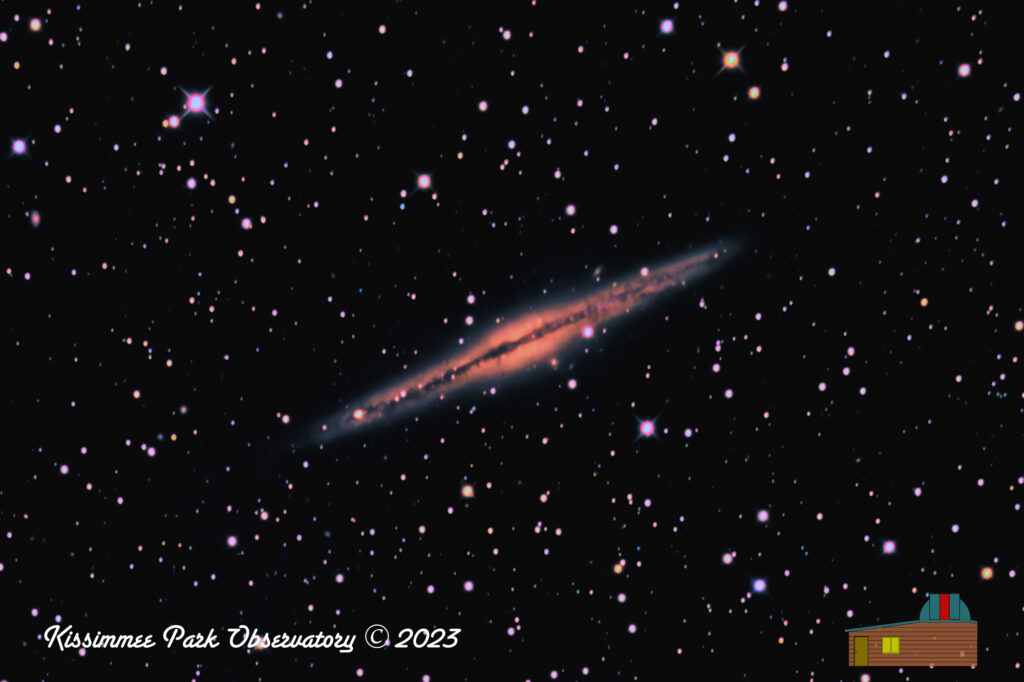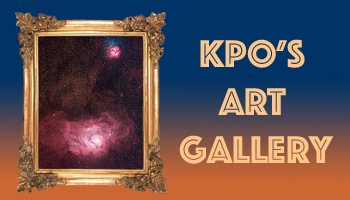
NGC 891, captured through the KPO RC-12 Astrograph. This is nearly 10 hours of integrated exposure, and is an LRGB image.
NGC 891: Exploring the Mysteries of the Outer Limits Galaxy
Located approximately 30 million light-years away in the constellation Andromeda, NGC 891 is one of the most captivating galaxies in the night sky. Often referred to as the “Outer Limits Galaxy,” NGC 891 offers astronomers and space enthusiasts a unique opportunity to unravel the mysteries hidden within its remarkable structure. Join us as we embark on an exciting journey to explore the secrets of this enigmatic celestial object.
A Needle Shape
NGC 891 is classified as an edge-on spiral galaxy, presenting an awe-inspiring sight when observed through telescopes. Its elongated shape, resembling a thin needle or a cosmic razor blade, is a result of its orientation with respect to our line of sight. This orientation provides a remarkable view of the galaxy’s intricate structure, allowing us to study its characteristics in detail.
Diving into the Dust
One of the most remarkable features of NGC 891 is the prominent dark band of dust that stretches across its midsection. This dense dust lane is believed to be composed of interstellar matter, which obscures the galaxy’s central bulge. The presence of this dust lane has made NGC 891 an enticing target for astronomers studying the interplay between dust, gas, and stars within galaxies.
Stellar Birth and Death
NGC 891 is a hotbed of stellar activity, with regions of intense star formation occurring throughout its disk. These regions offer a glimpse into the life cycle of stars. Massive stars are born from clouds of gas and dust, and their powerful radiation and stellar winds sculpt the surrounding material into stunning nebulae. As these stars eventually reach the end of their lives, they explode in brilliant supernovae, spreading their enriched material across the galaxy.
An X-ray Enigma
While NGC 891 is primarily known for its optical appearance, it also exhibits intriguing phenomena in the X-ray spectrum. NASA’s Chandra X-ray Observatory has detected X-ray emissions emanating from the galaxy’s central region. The source of this X-ray emission remains a mystery, leading scientists to speculate about the potential presence of an active galactic nucleus or a population of X-ray binary systems within NGC 891. Further observations and studies are needed to shed light on this enigma.
Unveiling the Dark Matter
NGC 891 has also played a crucial role in our understanding of dark matter. By studying the rotation of stars and gas within the galaxy, astronomers have been able to measure the gravitational effects of invisible matter. These measurements strongly suggest the presence of a massive dark matter halo enveloping the galaxy, providing further evidence for the existence of this elusive substance that pervades the universe.
Conclusion
NGC 891, the Outer Limits Galaxy, continues to captivate and intrigue astronomers with its stunning appearance and enigmatic features. From its elongated shape and prominent dust lane to its stellar birth and death, this galaxy offers a wealth of knowledge about the processes shaping our universe. As we continue to explore NGC 891 and other galaxies like it, we inch closer to unraveling the mysteries of the cosmos and our place within it.
Click on the image to view a larger version you can explore.
Image Info
- Imaged from KPO, in Saint Cloud, Florida
- Camera : ZWO ASI1600MM Pro
- Scope: Orion RC-12 Ritchey-Chretien Astrograph, 2450mm fl, F/8
- Mount: iOptron CEM-120
- Luminance: 62 subframes of 300s = 310 min integration
- Red: 23 subframes of 300s = 115 min integration
- Green: 19 subframes of 300s = 95 min integration
- Blue: 15 subframes of 300s = 75 min integration
- Total integration time: 595 min = 9.9 hours.
- Captured via ASIAir Pro automation
- Optical tracking via ASIAir automation via the ASI120MM-S guide camera
- Separate channels stacked and LRGB integrated in Astro Pixel Processor
- Image cropped and stretched in Nebulosity.
- Image run through Super DeNoising
- Final processing in Aperture
Buy this image as a print or framed art piece in our Art Gallery.

